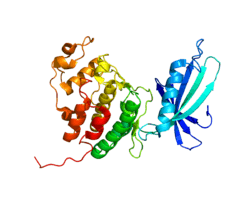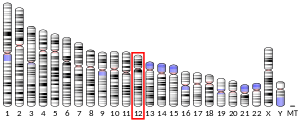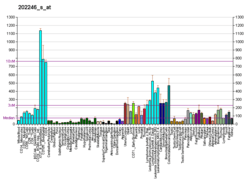Cyclin-dependent kinase 4
Cyclin-dependent kinase 4 also known as cell division protein kinase 4 is an enzyme that in humans is encoded by the CDK4 gene. CDK4 is a member of the cyclin-dependent kinase family.
Function
The protein encoded by this gene is a member of the Ser/Thr protein kinase family. This protein is highly similar to the gene products of S. cerevisiae cdc28 and S. pombe cdc2. It is a catalytic subunit of the protein kinase complex that is important for cell cycle G1 phase progression. The activity of this kinase is restricted to the G1-S phase, which is controlled by the regulatory subunits D-type cyclins and CDK inhibitor p16INK4a. This kinase was shown to be responsible for the phosphorylation of retinoblastoma gene product (Rb).[5] Ser/Thr-kinase component of cyclin D-CDK4 (DC) complexes that phosphorylate and inhibit members of the retinoblastoma (RB) protein family including RB1 and regulate the cell-cycle during G1/S transition. Phosphorylation of RB1 allows dissociation of the transcription factor E2F from the RB/E2F complexes and the subsequent transcription of E2F target genes which are responsible for the progression through the G1 phase. Hypophosphorylates RB1 in early G1 phase. Cyclin D-CDK4 complexes are major integrators of various mitogenic and antimitogenic signals. Also phosphorylates SMAD3 in a cell-cycle-dependent manner and represses its transcriptional activity. Component of the ternary complex, cyclin D/CDK4/CDKN1B, required for nuclear translocation and activity of the cyclin D-CDK4 complex.[6]
Clinical significance
Mutations in this gene as well as in its related proteins including D-type cyclins, p16(INK4a), CDKN2A and Rb were all found to be associated with tumorigenesis of a variety of cancers. One specific point mutation of CDK4 (R24C) was first identified in melanoma patients. This mutation was introduced also in animal models and its role as a cancer driver oncogene was studied thoroughly. Nowadays, deregulated CDK4 is considered to be a potential therapeutic target in some cancer types and various CDK4 inhibitors are being tested for cancer treatment in clinical trials.[7][8]
Multiple polyadenylation sites of this gene have been reported.[5]
It is regulated by Cyclin D.
Inhibitors
Ribociclib are US FDA approved CDK4 and CDK6 inhibitors for the treatment of estrogen receptor positive/ HER2 negative advanced breast cancer.[9]
See also CDK inhibitor for inhibitors of various CDKs.
Interactions
Cyclin-dependent kinase 4 has been shown to interact with:

References
- GRCh38: Ensembl release 89: ENSG00000135446 - Ensembl, May 2017
- GRCm38: Ensembl release 89: ENSMUSG00000006728 - Ensembl, May 2017
- "Human PubMed Reference:". National Center for Biotechnology Information, U.S. National Library of Medicine.
- "Mouse PubMed Reference:". National Center for Biotechnology Information, U.S. National Library of Medicine.
- "Entrez Gene: CDK4 cyclin-dependent kinase 4".
- https://www.uniprot.org/uniprot/P11802. Missing or empty
|title=(help) - Sheppard, K. E.; McArthur, G. A. (2013-10-01). "The Cell-Cycle Regulator CDK4: An Emerging Therapeutic Target in Melanoma". Clinical Cancer Research. 19 (19): 5320–5328. doi:10.1158/1078-0432.CCR-13-0259. ISSN 1078-0432. PMID 24089445.
- Sobhani; D’Angelo; Pittacolo; Roviello; Miccoli; Corona; Bernocchi; Generali; Otto (2019-04-06). "Updates on the CDK4/6 Inhibitory Strategy and Combinations in Breast Cancer". Cells. 8 (4): 321. doi:10.3390/cells8040321. ISSN 2073-4409. PMC 6523967. PMID 30959874.
- "Approved Drugs > Ribociclib (Kisqali)". Retrieved 12 September 2017.
- Ewing RM, Chu P, Elisma F, Li H, Taylor P, Climie S, McBroom-Cerajewski L, Robinson MD, O'Connor L, Li M, Taylor R, Dharsee M, Ho Y, Heilbut A, Moore L, Zhang S, Ornatsky O, Bukhman YV, Ethier M, Sheng Y, Vasilescu J, Abu-Farha M, Lambert JP, Duewel HS, Stewart II, Kuehl B, Hogue K, Colwill K, Gladwish K, Muskat B, Kinach R, Adams SL, Moran MF, Morin GB, Topaloglou T, Figeys D (2007). "Large-scale mapping of human protein-protein interactions by mass spectrometry". Mol. Syst. Biol. 3 (1): 89. doi:10.1038/msb4100134. PMC 1847948. PMID 17353931.
- Dai K, Kobayashi R, Beach D (1996). "Physical interaction of mammalian CDC37 with CDK4". J. Biol. Chem. 271 (36): 22030–4. doi:10.1074/jbc.271.36.22030. PMID 8703009.
- Lamphere L, Fiore F, Xu X, Brizuela L, Keezer S, Sardet C, Draetta GF, Gyuris J (1997). "Interaction between Cdc37 and Cdk4 in human cells". Oncogene. 14 (16): 1999–2004. doi:10.1038/sj.onc.1201036. PMID 9150368.
- Stepanova L, Leng X, Parker SB, Harper JW (1996). "Mammalian p50Cdc37 is a protein kinase-targeting subunit of Hsp90 that binds and stabilizes Cdk4". Genes Dev. 10 (12): 1491–502. doi:10.1101/gad.10.12.1491. PMID 8666233.
- Lin J, Jinno S, Okayama H (2001). "Cdk6-cyclin D3 complex evades inhibition by inhibitor proteins and uniquely controls cell's proliferation competence". Oncogene. 20 (16): 2000–9. doi:10.1038/sj.onc.1204375. PMID 11360184.
- Cariou S, Donovan JC, Flanagan WM, Milic A, Bhattacharya N, Slingerland JM (2000). "Down-regulation of p21WAF1/CIP1 or p27Kip1 abrogates antiestrogen-mediated cell cycle arrest in human breast cancer cells". Proc. Natl. Acad. Sci. U.S.A. 97 (16): 9042–6. Bibcode:2000PNAS...97.9042C. doi:10.1073/pnas.160016897. PMC 16818. PMID 10908655.
- Rual JF, Venkatesan K, Hao T, Hirozane-Kishikawa T, Dricot A, Li N, Berriz GF, Gibbons FD, Dreze M, Ayivi-Guedehoussou N, Klitgord N, Simon C, Boxem M, Milstein S, Rosenberg J, Goldberg DS, Zhang LV, Wong SL, Franklin G, Li S, Albala JS, Lim J, Fraughton C, Llamosas E, Cevik S, Bex C, Lamesch P, Sikorski RS, Vandenhaute J, Zoghbi HY, Smolyar A, Bosak S, Sequerra R, Doucette-Stamm L, Cusick ME, Hill DE, Roth FP, Vidal M (2005). "Towards a proteome-scale map of the human protein-protein interaction network". Nature. 437 (7062): 1173–8. Bibcode:2005Natur.437.1173R. doi:10.1038/nature04209. PMID 16189514.
- Ghavidel A, Cagney G, Emili A (2005). "A skeleton of the human protein interactome". Cell. 122 (6): 830–2. doi:10.1016/j.cell.2005.09.006. PMID 16179252.
- Guan KL, Jenkins CW, Li Y, Nichols MA, Wu X, O'Keefe CL, Matera AG, Xiong Y (1994). "Growth suppression by p18, a p16INK4/MTS1- and p14INK4B/MTS2-related CDK6 inhibitor, correlates with wild-type pRb function". Genes Dev. 8 (24): 2939–52. doi:10.1101/gad.8.24.2939. PMID 8001816.
- Wang H, Iakova P, Wilde M, Welm A, Goode T, Roesler WJ, Timchenko NA (2001). "C/EBPalpha arrests cell proliferation through direct inhibition of Cdk2 and Cdk4". Mol. Cell. 8 (4): 817–28. doi:10.1016/S1097-2765(01)00366-5. PMID 11684017.
- Sugimoto M, Nakamura T, Ohtani N, Hampson L, Hampson IN, Shimamoto A, Furuichi Y, Okumura K, Niwa S, Taya Y, Hara E (1999). "Regulation of CDK4 activity by a novel CDK4-binding protein, p34(SEI-1)". Genes Dev. 13 (22): 3027–33. doi:10.1101/gad.13.22.3027. PMC 317153. PMID 10580009.
- Nasmyth K, Hunt T (1993). "Cell cycle. Dams and sluices". Nature. 366 (6456): 634–5. doi:10.1038/366634a0. PMID 8259207.
- Taulés M, Rius E, Talaya D, López-Girona A, Bachs O, Agell N (1998). "Calmodulin is essential for cyclin-dependent kinase 4 (Cdk4) activity and nuclear accumulation of cyclin D1-Cdk4 during G1". J. Biol. Chem. 273 (50): 33279–86. doi:10.1074/jbc.273.50.33279. PMID 9837900.
- Coleman KG, Wautlet BS, Morrissey D, Mulheron J, Sedman SA, Brinkley P, Price S, Webster KR (1997). "Identification of CDK4 sequences involved in cyclin D1 and p16 binding". J. Biol. Chem. 272 (30): 18869–74. doi:10.1074/jbc.272.30.18869. PMID 9228064.
- Arsenijevic T, Degraef C, Dumont JE, Roger PP, Pirson I (2004). "A novel partner for D-type cyclins: protein kinase A-anchoring protein AKAP95". Biochem. J. 378 (Pt 2): 673–9. doi:10.1042/BJ20031765. PMC 1223988. PMID 14641107.
- Zhang Q, Wang X, Wolgemuth DJ (1999). "Developmentally regulated expression of cyclin D3 and its potential in vivo interacting proteins during murine gametogenesis". Endocrinology. 140 (6): 2790–800. doi:10.1210/endo.140.6.6756. PMID 10342870.
- Zhang JM, Zhao X, Wei Q, Paterson BM (1999). "Direct inhibition of G(1) cdk kinase activity by MyoD promotes myoblast cell cycle withdrawal and terminal differentiation". EMBO J. 18 (24): 6983–93. doi:10.1093/emboj/18.24.6983. PMC 1171761. PMID 10601020.
- Zhang JM, Wei Q, Zhao X, Paterson BM (1999). "Coupling of the cell cycle and myogenesis through the cyclin D1-dependent interaction of MyoD with cdk4". EMBO J. 18 (4): 926–33. doi:10.1093/emboj/18.4.926. PMC 1171185. PMID 10022835.
- Fåhraeus R, Paramio JM, Ball KL, Laín S, Lane DP (1996). "Inhibition of pRb phosphorylation and cell-cycle progression by a 20-residue peptide derived from p16CDKN2/INK4A" (PDF). Curr. Biol. 6 (1): 84–91. doi:10.1016/S0960-9822(02)00425-6. PMID 8805225.
- Li J, Melvin WS, Tsai MD, Muscarella P (2004). "The nuclear protein p34SEI-1 regulates the kinase activity of cyclin-dependent kinase 4 in a concentration-dependent manner". Biochemistry. 43 (14): 4394–9. CiteSeerX 10.1.1.386.140. doi:10.1021/bi035601s. PMID 15065884.
- Xiong Y, Zhang H, Beach D (1993). "Subunit rearrangement of the cyclin-dependent kinases is associated with cellular transformation". Genes Dev. 7 (8): 1572–83. doi:10.1101/gad.7.8.1572. PMID 8101826.
Further reading
- Hanks SK (1987). "Homology probing: identification of cDNA clones encoding members of the protein-serine kinase family". Proc. Natl. Acad. Sci. U.S.A. 84 (2): 388–92. Bibcode:1987PNAS...84..388H. doi:10.1073/pnas.84.2.388. PMC 304212. PMID 2948189.
- Hall M, Bates S, Peters G (1995). "Evidence for different modes of action of cyclin-dependent kinase inhibitors: p15 and p16 bind to kinases, p21 and p27 bind to cyclins". Oncogene. 11 (8): 1581–8. PMID 7478582.
- Tassan JP, Jaquenoud M, Léopold P, et al. (1995). "Identification of human cyclin-dependent kinase 8, a putative protein kinase partner for cyclin C". Proc. Natl. Acad. Sci. U.S.A. 92 (19): 8871–5. Bibcode:1995PNAS...92.8871T. doi:10.1073/pnas.92.19.8871. PMC 41069. PMID 7568034.
- Mitchell EL, White GR, Santibanez-Koref MF, et al. (1995). "Mapping of gene loci in the Q13-Q15 region of chromosome 12". Chromosome Res. 3 (4): 261–2. doi:10.1007/BF00713052. PMID 7606365.
- Wölfel T, Hauer M, Schneider J, et al. (1995). "A p16INK4a-insensitive CDK4 mutant targeted by cytolytic T lymphocytes in a human melanoma". Science. 269 (5228): 1281–4. doi:10.1126/science.7652577. PMID 7652577.
- Hirai H, Roussel MF, Kato JY, et al. (1995). "Novel INK4 proteins, p19 and p18, are specific inhibitors of the cyclin D-dependent kinases CDK4 and CDK6". Mol. Cell. Biol. 15 (5): 2672–81. doi:10.1128/MCB.15.5.2672. PMC 230497. PMID 7739547.
- Chan FK, Zhang J, Cheng L, et al. (1995). "Identification of human and mouse p19, a novel CDK4 and CDK6 inhibitor with homology to p16ink4". Mol. Cell. Biol. 15 (5): 2682–8. doi:10.1128/MCB.15.5.2682. PMC 230498. PMID 7739548.
- Guan KL, Jenkins CW, Li Y, et al. (1995). "Growth suppression by p18, a p16INK4/MTS1- and p14INK4B/MTS2-related CDK6 inhibitor, correlates with wild-type pRb function". Genes Dev. 8 (24): 2939–52. doi:10.1101/gad.8.24.2939. PMID 8001816.
- Kato JY, Matsuoka M, Strom DK, Sherr CJ (1994). "Regulation of cyclin D-dependent kinase 4 (cdk4) by cdk4-activating kinase". Mol. Cell. Biol. 14 (4): 2713–21. doi:10.1128/MCB.14.4.2713. PMC 358637. PMID 8139570.
- Khatib ZA, Matsushime H, Valentine M, et al. (1993). "Coamplification of the CDK4 gene with MDM2 and GLI in human sarcomas". Cancer Res. 53 (22): 5535–41. PMID 8221695.
- Serrano M, Hannon GJ, Beach D (1994). "A new regulatory motif in cell-cycle control causing specific inhibition of cyclin D/CDK4". Nature. 366 (6456): 704–7. Bibcode:1993Natur.366..704S. doi:10.1038/366704a0. PMID 8259215.
- Demetrick DJ, Zhang H, Beach DH (1994). "Chromosomal mapping of human CDK2, CDK4, and CDK5 cell cycle kinase genes". Cytogenet. Cell Genet. 66 (1): 72–4. doi:10.1159/000133669. PMID 8275715.
- Kato J, Matsushime H, Hiebert SW, et al. (1993). "Direct binding of cyclin D to the retinoblastoma gene product (pRb) and pRb phosphorylation by the cyclin D-dependent kinase CDK4". Genes Dev. 7 (3): 331–42. doi:10.1101/gad.7.3.331. PMID 8449399.
- Zuo L, Weger J, Yang Q, et al. (1996). "Germline mutations in the p16INK4a binding domain of CDK4 in familial melanoma". Nat. Genet. 12 (1): 97–9. doi:10.1038/ng0196-97. PMID 8528263.
- Andersson B, Wentland MA, Ricafrente JY, et al. (1996). "A "double adaptor" method for improved shotgun library construction". Anal. Biochem. 236 (1): 107–13. doi:10.1006/abio.1996.0138. PMID 8619474.
- Knudsen ES, Wang JY (1996). "Differential regulation of retinoblastoma protein function by specific Cdk phosphorylation sites". J. Biol. Chem. 271 (14): 8313–20. doi:10.1074/jbc.271.14.8313. PMID 8626527.
- Poon RY, Jiang W, Toyoshima H, Hunter T (1996). "Cyclin-dependent kinases are inactivated by a combination of p21 and Thr-14/Tyr-15 phosphorylation after UV-induced DNA damage". J. Biol. Chem. 271 (22): 13283–91. doi:10.1074/jbc.271.22.13283. PMID 8662825.
- Stepanova L, Leng X, Parker SB, Harper JW (1996). "Mammalian p50Cdc37 is a protein kinase-targeting subunit of Hsp90 that binds and stabilizes Cdk4". Genes Dev. 10 (12): 1491–502. doi:10.1101/gad.10.12.1491. PMID 8666233.
- Dai K, Kobayashi R, Beach D (1996). "Physical interaction of mammalian CDC37 with CDK4". J. Biol. Chem. 271 (36): 22030–4. doi:10.1074/jbc.271.36.22030. PMID 8703009.
- Fåhraeus R, Paramio JM, Ball KL, et al. (1996). "Inhibition of pRb phosphorylation and cell-cycle progression by a 20-residue peptide derived from p16CDKN2/INK4A" (PDF). Curr. Biol. 6 (1): 84–91. doi:10.1016/S0960-9822(02)00425-6. PMID 8805225.
External links
- Cyclin-Dependent+Kinase+4 at the US National Library of Medicine Medical Subject Headings (MeSH)
- CDK4 human gene location in the UCSC Genome Browser.
- CDK4 human gene details in the UCSC Genome Browser.





